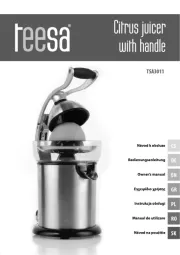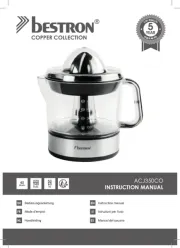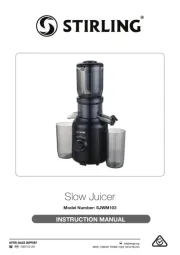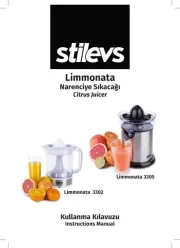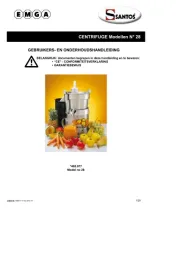Bosch VitaJuice 2 MES25A0 Manual
Læs gratis den danske manual til Bosch VitaJuice 2 MES25A0 (137 sider) i kategorien Saftpresser. Denne vejledning er vurderet som hjælpsom af 101 personer og har en gennemsnitlig bedømmelse på 4.8 stjerner ud af 51 anmeldelser.
Har du et spørgsmål om Bosch VitaJuice 2 MES25A0, eller vil du spørge andre brugere om produktet?

Produkt Specifikationer
| Mærke: | Bosch |
| Kategori: | Saftpresser |
| Model: | VitaJuice 2 MES25A0 |
| Tænd-/slukkontakt: | Ja |
| Vekselstrømsindgangsspænding: | 220 - 240 V |
| Vekselstrømsindgangsfrekvens: | 50 - 60 Hz |
| Bredde: | 310 mm |
| Dybde: | 312 mm |
| Højde: | 180 mm |
| Vægt: | 5000 g |
| Brugervejledning: | Ja |
| Produktfarve: | Black, White |
| Kontroltype: | Dreje |
| Antal hastigheder: | 2 |
| Produkttype: | Frugtpresser |
| Strøm: | 700 W |
| Pakkevægt: | 5300 g |
| Pakkedybde: | 355 mm |
| Pakkebredde: | 255 mm |
| Pakkehøjde: | 450 mm |
| Variabel hastighed: | Ja |
| Husmateriale: | Plast |
| Farve på kontrolpanel: | Sort, sølv |
| Dele der tåler opvaskemaskine: | Ja |
| Produkter pr. palle: | 36 stk |
| Nem at rengøre: | Ja |
| Skridsikre fødder: | Ja |
| Ledningsopbevaring: | Ja |
| Oprindelsesland: | Tyskland |
| Rengøringsbørste: | Ja |
| Filtermateriale: | Rustfrit stål |
| Anti-dryp funktion: | Ja |
| Omvendt: | Ingen |
| Beholder til frugtkød: | 2 L |
| Impulsfunktion: | Ingen |
| Låg med påfyldningshul: | Ja |
| Sikkerhedsafbryder: | Ja |
| Sikkerhedsklemmer: | Ja |
| Diameter på påfyldningsrør: | 73 mm |
| Hastighedskontrol type: | Trin |
| Pulpbeholder: | Ja |
| Saftbeholder: | Ja |
| Juice beholder kapacitet: | 1.25 L |
| Aftagelig saftbeholder: | Ja |
| Materiale, knive: | Rustfrit stål |
| Kande: | Ja |
| Måling af væske: | Ingen |
| Lågmateriale: | Plast |
| Skum separator: | Ja |
| Aftagelig pulpbeholder: | Ja |
| Antal tryk kegler: | 1 |
| Tilbehør, der tåler opvaskemaskine: | Ja |
| Mad pusher: | Ja |
| Velegnet til frugt/græntsager type: | Blød/hård |
| Kontinuerlig påfyldning: | Ja |
| Låsesystem: | Sikkerhedsklemme |
| Garantiperiode: | 2 År |
| Materiale, skubber: | Plast |
| Materiale, kande: | Plast |
| Automatisk udslyngning af pulp: | Ja |
| Gennemsigtigt låg: | Ja |
Har du brug for hjælp?
Hvis du har brug for hjælp til Bosch VitaJuice 2 MES25A0 stil et spørgsmål nedenfor, og andre brugere vil svare dig
Saftpresser Bosch Manualer




Saftpresser Manualer
- Weston
- Sogo
- Trisa
- Choice
- Brandt
- Heinner
- Aicok
- Create
- Solac
- Magimix
- SilverCrest
- Eta
- Klarstein
- Philips
- MPM
Nyeste Saftpresser Manualer



